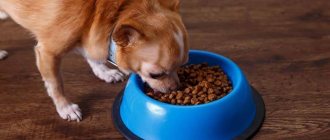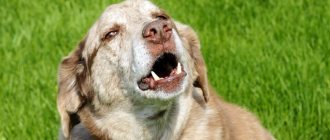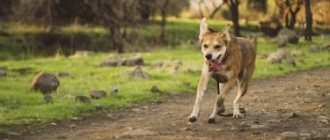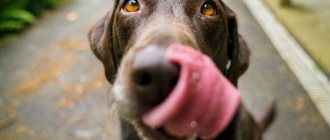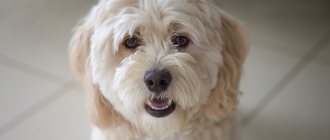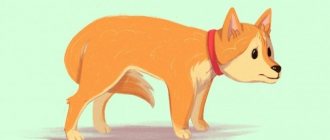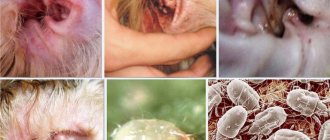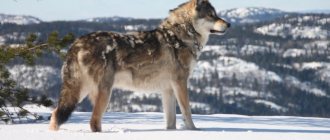Dangerous and not so symptoms of apathy in a dog. The first signs of how to treat and prevent apathy.
It is common for a person to wake up sleep deprived after a hard day at work or a night at the club. This condition is rare for animals. They don't get up with a broken head. If a usually active and cheerful dog does not get up all day and does not want to go outside for a walk, then you should worry about its health.
Apathy is a state when a dog does not want to play, eat, or walk. She wants to be left alone. This condition can be caused by various reasons. Many are not dangerous to health, but there are exceptions.
Forms of myositis: a brief overview
Taking into account the clinical picture and the area of muscle damage, different forms of myositis are distinguished. The most common among dogs include:
Traumatic. The main sign of traumatic myositis in dogs is slow and sluggish movements. The pet is careful, but does not move well. It is noticeable that he is trying to protect the affected area. Additional symptoms include lack of appetite and the appearance of lumps (swelling) in the area of muscle tissue. They may differ in size, but when you touch them, your pet experiences severe pain. The muscle that has been damaged as a result of the disease increases in volume and becomes more tense.
Purulent (infectious) . It is distinguished from other types of myositis by the fact that an infectious pathogen (rickettsia, streptococci, etc.) penetrates into the damaged area. Specific symptoms of purulent myositis include high body temperature of the animal and an abscess, i.e. purulent inflammation of tissues and the appearance of a purulent cavity. This is the most dangerous form of myositis, as it can trigger the development of sepsis. Additional symptoms include lethargy, depression, and minimal mobility.
Rheumatic . In more than 85% of cases, the factor causing this form of myositis in dogs is hypothermia. The disease is often diagnosed in pets kept outdoors even in the winter (for example, in a cold enclosure or on a chain). Hypothermia of the body leads to the development of an inflammatory reaction, which can spread to neighboring areas of the body. This form of the disease is accompanied by severe pain. Even simply touching the affected area causes extreme stress in the animal.
Eosinophilic . Unfortunately, the causes of this form of myositis have not been studied. It is known that it is of an autoimmune nature, and therefore it is often classified as a hereditary disease. The main feature of eosinophilic myositis is damage to the jaw muscles, which is why it is often called masticatory myositis in dogs. This condition is accompanied by convulsive tension and swelling of the muscles. Characteristic signs include hyperemia of the conjunctiva of the eye.
Dog diseases: distemper - symptoms
Distemper in dogs is a viral disease characterized by damage to the skin, digestive and respiratory organs; in rare cases, the development of meningitis and encephalitis is noted. The virus affects dogs of all ages, although dogs between one month and two years of age are predominantly affected. Even marine animals are susceptible to the disease. Terriers and boxers are considered relatively resistant to canine distemper; humans do not get sick.
Clinical signs of plague are varied:
Asymptomatic virus carriage or a lightning-fast, violent course occurs. The duration of the disease can range from several days or weeks to several months. When the clinical picture of the disease is dominated by symptoms of damage to the respiratory system, they speak of a pulmonary form of the disease, when the nervous system is extensively affected, they speak of a nervous form. This division is arbitrary; symptoms of damage to the digestive organs often prevail in the clinical picture. Sometimes there is a combination of damage to the respiratory system and skin, the nervous system becomes the final stage of the development of the disease.
Canine distemper begins to manifest itself with the appearance of a pustular or macular rash on the inner surfaces of the thighs, with a runny nose, diarrhea, depression of consciousness, temporary refusal to feed, and redness of the conjunctiva. As a rule, there is an increase in body temperature, although, for example, in dwarf poodles or some other breeds of dogs, the plague occurs against a background of normal temperature. At the same time, the animal hides in dark places and refuses to walk. The dog's skin becomes dry.
It is possible to develop hyperkeratosis on the elbows and small focal baldness. There are discharges from the nose, which are transparent in the first stages of the development of the disease, but become mucopurulent over time. Sometimes there is clouding of the cornea, sticking or redness of the eyelids, shortness of breath appears, and wheezing is heard. The intestinal form of the disease is characterized by the development of diarrhea and vomiting.
Symptoms of damage to the nervous system include the appearance of tics, which begin in the muscles of the head. At the first stages it is not intense, but later it spreads to the limbs and becomes pronounced, as a result the animals do not sleep at night and often whine. Paralysis, paresis, and hyperkinesis gradually develop. At the last stage, meningoencephalitis develops, which is accompanied by severe intoxication and ends in death.
Treatment is prescribed only by a veterinarian.
Causes of myositis in dogs
With myositis, the inflammatory process affects one or several muscles at once (for example, the muscles of the lower leg and hip joint). The danger of the disease is that inflammation can spread to neighboring areas of the body, as well as affect the connective tissues of internal organs and nerve endings.
Reasons that can trigger the occurrence of myositis include:
- hypothermia of the body;
- old age of the pet (often this factor leads to the development of rheumatic myositis in dogs);
- increased muscle mass;
- weak immunity;
- viral and bacterial infections;
- heavy physical activity;
- intensive training in the absence of proper preparation;
- muscle damage (sprain, tear);
- genetic predisposition.
On a note! In some cases, muscle inflammation in a dog is caused by not one, but several reasons. For example, hypothermia (long walk in the rain) and old age. The combination of these factors provokes the development of myositis and requires immediate seeking veterinary help in Moscow.
At risk, i.e. In the category of animals that are more susceptible to myositis than others, there are working breeds of dogs - herding, hunting, and service dogs. These include German shepherds, West Siberian huskies, Rottweilers, St. Bernards, Dobermans, etc. This is due to the fact that they regularly experience increased physical activity .
Should I contact a veterinarian?
If your dog does require medical intervention, there are many things that can be done for him under the guidance of a veterinarian.
If you are concerned about any alarming symptoms or complications related to your dog's rhythm, you may want to call your veterinarian.
In a few minutes, you will know if your dog's problem is more serious and what you can do to help him faster when it comes to any related problems with your dog not lying down and walking.
Beyond your immediate concerns, there is some good news. Stimulation is a common problem in dogs and usually has simple solutions, so here are a few for you to consider.
Signs of disease: how to understand that your pet needs help?
It is quite difficult to recognize myositis in a dog at the initial stage. The first thing that should alert the owner is stiffness and difficulty in movement. At the first stage, this condition is observed in the morning or after a long sleep. The pet moves very carefully and carefully. The “doll” gait persists throughout the day.
Other signs indicating the development of traumatic, purulent (infectious) or other forms of myositis:
- Soreness . When palpating the affected area, the dog experiences severe pain. This is expressed by aggression (the pet growls, grins) or loud squealing. Pain also occurs with sudden movements, so the dog behaves carefully: does not run, does not jump on heights, etc.
- Increased body temperature . The main feature is that the temperature is elevated over a long period of time, and in particular, this applies to the affected area of the body. When palpating, you will notice that the skin at the site of inflammation is dry and hot.
- Decreased appetite. This symptom occurs in all forms of the disease, but it is most pronounced in eosinophilic myositis. Due to inflammation of the chewing muscles, the dog practically cannot open its mouth, so it is very painful for it to eat and even drink water.
- Muscular dystrophy. Cellular metabolism disorders and soft tissue degeneration. Like loss of appetite, this symptom is most pronounced with eosinophilic myositis. The jaw muscles become much smaller in size (almost dry out), and noticeable depressions form in the zygomatic area.
- Additional signs. Your pet may experience anorexia, loss of muscle mass, dehydration, protruding eyeballs, and swelling in various parts of the body. Possible atrophy of the masticatory muscles, purulent lesions, etc.
Have you noticed signs in your pet that indicate the development of myositis? Don't hesitate - contact a veterinary clinic! Only an experienced veterinarian will be able to correctly diagnose and prescribe effective treatment to prevent the onset of dangerous consequences of the disease.
How to stop a dog from whining when alone
To prevent your dog from whining throughout its life, remember that it is much more difficult to retrain an adult pet. You need to start from puppyhood.
We lock the pet in one of the rooms and go out the door. The puppy must understand that the owner has left. The baby's first reaction: scratching the doors and light whining. Come back, scold him slightly, lifting him by the scruff of the neck, but don’t hit him or scare him with a loud scream. If he whines a little and calms down, then come back, praise him, and treat him with a treat.
Repeat your “care” several times; the amplitude should increase over time. If your dog whines, don't run to it and don't come back. She is waiting for a similar reaction from the owner and next time the reward simply won’t work.
This is a great way to stop your puppy from whining at night. Teach your pet to the “Place” command from an early age. He should sit or lie in a specially designated place waiting for you. If the dog gets tired and starts moving around the room, it’s not a big deal, as long as it doesn’t bark or whine.
If an animal walks around you and whines, ignore it. This is a provocation and manipulation to attract attention. Do not lose your authority, the owner should communicate with the pet when he wants it, and not vice versa. This is the most correct answer to the question of how to stop a puppy from whining.
Train your puppy while walking. He must receive the maximum load during the walk so that the pet does his best physically.
How is the diagnosis done?
Diagnosis of myositis includes a complete physical (general examination, assessment of the condition of the skin, etc.) and neurological examination. The veterinarian will examine the oral cavity if the masticatory muscles are damaged. Additionally, a medical history is taken to exclude injuries that could cause the development of the disease.
To make an accurate diagnosis, different methods are used:
- laboratory testing of blood and urine;
- chest x-ray;
- Ultrasound of the abdominal area;
- tests for the presence of an infectious pathogen;
- biopsy;
- cytological examination, etc.
It is impossible to make a diagnosis on your own and at home. Myositis in dogs requires contacting a veterinarian, so do not risk the health and life of your pet - entrust the diagnosis and treatment of the animal to professionals!
Why does my pet whine?
This question worries many breeders and dog owners. Why does a dog whine for no reason?
- Expression of animal emotions. Your furry pet cannot do this in any other way.
- The dog got sick. The cause may be injury or pathology of internal organs. With this behavior he attracts attention to himself or asks for help from the owner. It is worth paying attention if the pet is whining, and in addition, he has a bowel disorder, is shivering, the dog becomes lethargic, does not eat, or has a poor appetite.
- To attract attention. With such signs, the animal asks to take a walk or play with it or treat it with something tasty.
- The sadness of loneliness. If the owner is constantly traveling or at work, then the pet will often lack communication and affection.
- Wild joy or delight. The dog jumps, barks, whines, runs around the person, expressing its emotions in such an unrestrained way, and can uncontrollably grab everything from the floor or ground.
- Apology, guilt. Sometimes a pet may whine after doing something wrong or being caught doing something wrong. Often such whining is accompanied by flattening of the ears and drooping eyes.
- Nothing to occupy yourself with. Sometimes puppies and adult dogs are unable to entertain themselves on their own and, being confined to four walls for a long time, begin to whine and may even run away.
- Defecation. The dog hasn't been walked for a long time and his bladder is full, so he can't hold back and needs to go to the toilet (how to tame it).
- Fright. This reaction happens when meeting an aggressive animal on the street, going to the vet, traveling or changing the environment.
Treatment of myositis in dogs
The main goal of treatment is to eliminate the cause that provoked the development of myositis in a dog . If it cannot be found, procedures and medications are prescribed to eliminate the main signs of the disease (for example, pain) and improve the general condition of the pet.
For muscle inflammation, compresses are prescribed - cold and warm. They are performed not only in the clinic, but also at home. If the animal's skin is severely damaged, a ligament or muscle rupture is diagnosed, stitches are placed and antibiotics are prescribed.
Ultrasound and physiotherapeutic procedures are performed according to indications. They are designed to restore and strengthen the muscle frame, as well as the general condition of the pet. Often dogs are prescribed therapeutic massage, the course of which includes from 4 to 8 sessions or more.
If a dog is diagnosed with a purulent form, the doctor opens the abscess. This is necessary to remove purulent fluid (blood mixed with pus). After this, antibacterial therapy is prescribed. To support the liver, which is under stress from antibiotics, a specialist prescribes hepatoprotectors.
For eosinophilic myositis, only symptomatic therapy is used - taking hormones. Warming compresses are applied to the affected areas. Blood transfusions are performed according to indications. The pet is fed artificially.
If you seek veterinary help in a timely manner, treatment will take minimal time (usually from 3 to 15 days).
In what cases is a visit to the clinic strictly necessary?
In order to prevent serious nervous disorders in your dog, let’s consider in which cases a visit to the clinic is strictly necessary:
- with a sharp deterioration in condition;
- impairment of respiratory and cardiac function;
- uncharacteristic, inappropriate behavior;
- the appearance of the first symptoms of systemic failures, diseases (refusal to eat, pale mucous membranes, fever, apathy, temperature, diarrhea, vomiting, muscle spasms, cramps);
- with chronic stress.
Possible complications
If you do not seek veterinary help in time (or do not diagnose the disease correctly), the inflammation will continue to develop and begin to affect nearby areas of the body. In this case, it will be almost impossible to stop the inflammatory process without consequences. Complications that are possible with myositis in dogs include:
- weakening of one or several muscles at once, up to complete death (in which case they cease to perform their functions);
- further spread of the infectious disease and the occurrence of abscesses (purulent lesions);
- change in size of one or more damaged muscles - they become deformed and become noticeably shorter;
- Deterioration of vision in an animal is one of the common consequences of eosinophilic myositis.
Working with an adult pet
Often a dog comes into the home as an adult, fully formed individual, be it a dog adopted from a shelter, a foundling, or a pet of friends or acquaintances.
If a dog loses sight of its owner on the street and whines or makes these sounds in anticipation of some event, then such a pet should be taught to concentrate with the help of praise and goodies.
To train a dog to stop whining or howling indoors, use the same method as for a puppy. But remember that the process will take longer due to the age of the pet.
You cannot calm an animal down or praise it if it whines. She will take this as approval and will repeat this action over and over again. The owner should not aggravate the problem, but behave as if the owner of the pack is tough and fair.
You should not hit your pet; in rare cases, the strict command “Fu!”, spoken in a stern voice, is allowed. This way, the dog will feel inner strength and will probably obey. When obedient, grab your dog.
Another important point is not to let your pet out for a walk or to open the door when she barks or whines. Say “Ugh!”, wait until she stops making these sounds and only then release her. If the animal is kept in an enclosure, then accustom it to the place. You should only pet and encourage her when she calms down and becomes silent.
If your dog whines while driving, as soon as he starts doing this, close the curtains to prevent him from looking out the window. Don't get distracted and don't shout, you can command “Ugh!” or “Place!”
Recommendations
If your pet howls or whines from loneliness, then take her for a good walk before work in the morning. A fed and tired dog will rest and sleep longer, and therefore whine less.
Don't forget to leave toys for your animal to chew on. This will calm her nerves, strengthen her gums, and occupy her free time. And besides, you will protect yourself from torn slippers, chewed wires, etc.
What to do at home?
The main thing is to create a comfortable environment for your pet. Do not forget that any measures taken at home are discussed in advance with a veterinarian and are taken only after diagnosis and general treatment of the disease in the clinic!
At home, the dog should have a warm, soft place (preferably a bed), free access to clean drinking water and good nutrition. These measures will help the animal’s body, weakened due to the disease, recover much faster and overcome myositis without health consequences.
At home, continue to follow all the veterinarian’s recommendations (give medications as prescribed, apply special compresses, visit the clinic in a timely manner for examinations and adjustments to prescriptions, etc.).
At home, you need to provide your pet with proper nutrition. A prerequisite is compliance with the drinking regime (water, decoctions). It will allow a weakened body to recover faster from an illness.
Your veterinarian will give you dietary advice at your appointment. Experts usually recommend adding more foods with vitamins A, E and C (vegetable oil, bell peppers, etc.) to your diet. The fact is that they strengthen the immune system and the entire body.
Don't forget about easily digestible proteins. They are found in large quantities in ground beef, chicken and almonds. Another tip is to add foods high in calcium and zinc to your diet (liver, cereals, dairy products).
These useful recommendations will help you not only keep your pet healthy, but also ensure its rapid recovery after suffering from myositis!
What to do if your puppy whines at night
A dog is, first and foremost, a pack animal by nature. If a young puppy begins to whine, bark or make some other sounds at night, this only indicates that in this way he attracts the attention of his relatives. He was used to sleeping near the warm body of the female who gave birth to him, and not being in splendid isolation, albeit on a bedding, but also in love. He may be scared and cold. It is easier to solve this problem by moving the puppy to the owner overnight.
You can also use the "fu" command. It must be pronounced quite firmly and confidently. The first time the dog does not always understand what they want from him, but by the third or fourth time he gradually stops making sounds. When this happens, you should definitely praise your pet for it.
The “fu” command shows that the owner is the boss in the house. From a young age, the dog needs to realize this. The animal is educated only by voice, and not by physical beatings. In this case, the animal can be psychologically traumatized.
Often, if a puppy whines at night, he receives little attention during the day. Often it is not possible to spend much time with him due to work or other matters, but it is still better to compensate for this shortcoming in some way. First of all, this concerns walks. If the puppy becomes physically developed and a little tired, he will need to pay less attention. As a result, he will have less reason to whine or make other sounds at night.
Proper nutrition should also be ensured. It must occur in accordance with the regime. This also applies to access to water when using dry food. This type of food dehydrates the body quite strongly, so the animal will always require the proper level of fluid. If it is not there, it will begin to make sounds or get nervous.
In addition, the puppy should always have his favorite toys and a teeth sharpener in his field of vision. They can help redirect his attention so that he stops whining.
It is important to understand that the effectiveness of all of the above methods can only be achieved with an integrated approach to raising your little pet. All the factors described above in one way or another affect his physical and psychological state. He should be as comfortable as possible with his owner, so that the thought of living with other animals does not even occur to him.
Breed selection
The choice of breed when purchasing a pet is also important. Remember that mixtures of breeds behave unpredictably and it is almost impossible to predict their future character. The quietest breeds, according to breeders and owners, are the Irish Setter and the Staffordshire Bull Terrier.
But the beautiful and imposing husky loves to howl, pugs and sharpeis will not bark much, but they grunt and snore.
The most silent breeds
If you do not like noisy dogs or those prone to howling and barking, then before choosing a pet you should choose a more silent breed.
- Basenji. These animals do not bark, but may purr when unhappy or howl slightly.
- Bullmastiff. A large, beautiful animal, it can be a protector for families and children; it prefers to snort and sniffle.
- Deerhound. This breed is perfect for indoors and will not bother you with barking, whining or howling.
- Afghan Hound. An elegant pet with high intelligence, attached to its owners.
- Shar Pei. It is distinguished by high devotion to its owners, barks and whines little. Mostly barks when playing or in danger.
- Ridgeback. A strong, powerful animal that is perfect as a protector. Characterized by silence. They need long walks and fresh air.
- Akita Inu. A dog with a powerful physique, silent until she is in danger.
- Greyhound. A companion pet with great speed and energy. Silent.
- Russian greyhound. The dog is graceful and not lacking in grace, moves a lot, makes little noise.
Currently reading:
- Recommendations for obedience of a dog if it growls
- Games to choose for training a dog
- The American Cocker Spaniel is an adroit hunter and loyal friend.
- Actions to take in case of an epileptic attack and a shaking dog
